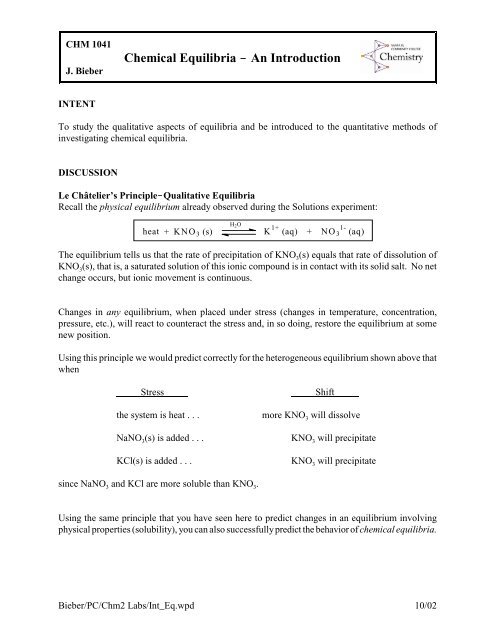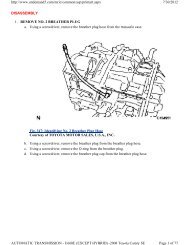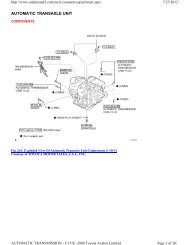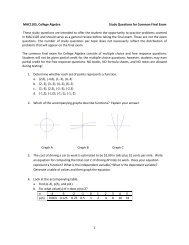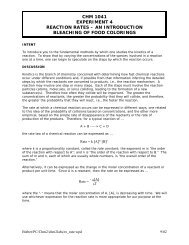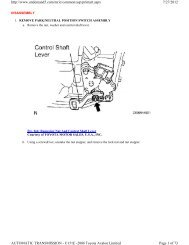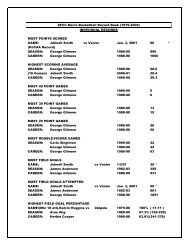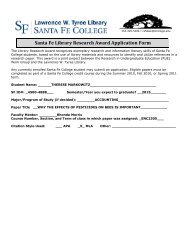Chemical Equilibria ! An Introduction - Santa Fe College
Chemical Equilibria ! An Introduction - Santa Fe College
Chemical Equilibria ! An Introduction - Santa Fe College
Create successful ePaper yourself
Turn your PDF publications into a flip-book with our unique Google optimized e-Paper software.
CHM 1041<br />
J. Bieber<br />
INTENT<br />
<strong>Chemical</strong> <strong>Equilibria</strong> ! <strong>An</strong> <strong>Introduction</strong><br />
To study the qualitative aspects of equilibria and be introduced to the quantitative methods of<br />
investigating chemical equilibria.<br />
DISCUSSION<br />
Le Châtelier’s Principle!Qualitative <strong>Equilibria</strong><br />
Recall the physical equilibrium already observed during the Solutions experiment:<br />
H 2O<br />
+ KNO3 (s)<br />
K +<br />
1+ (aq) NO 3 1- heat<br />
(aq)<br />
The equilibrium tells us that the rate of precipitation of KNO 3(s) equals that rate of dissolution of<br />
KNO 3(s), that is, a saturated solution of this ionic compound is in contact with its solid salt. No net<br />
change occurs, but ionic movement is continuous.<br />
Changes in any equilibrium, when placed under stress (changes in temperature, concentration,<br />
pressure, etc.), will react to counteract the stress and, in so doing, restore the equilibrium at some<br />
new position.<br />
Using this principle we would predict correctly for the heterogeneous equilibrium shown above that<br />
when<br />
Stress Shift<br />
the system is heat . . . more KNO 3 will dissolve<br />
NaNO 3(s) is added . . . KNO 3 will precipitate<br />
KCl(s) is added . . . KNO 3 will precipitate<br />
since NaNO 3 and KCl are more soluble than KNO 3.<br />
Using the same principle that you have seen here to predict changes in an equilibrium involving<br />
physical properties (solubility), you can also successfully predict the behavior of chemical equilibria.<br />
Bieber/PC/Chm2 Labs/Int_Eq.wpd 10/02
Acid/Base <strong>Equilibria</strong><br />
In your first course in chemistry you were introduced to the concepts of acids and bases. You have<br />
seen that different acids have different strengths; and as a result some acids are classified as strong<br />
acids, others as weak. If an acid reacts to a large extent with water to form its conjugate base and<br />
hydronium ion, then the acid a strong acid. However, how large is large?<br />
Now that we will begin to look at acids and bases quantitatively, we need a more precise definition.<br />
A strong acid is defined as any acid that reacts with water more than 50% to yield its conjugate base<br />
and hydronium ion. When this happens the principal species in the solution, and the ones which<br />
should be used in writing any principal equations involving those solutions, are the products of that<br />
reaction with water.<br />
For example, an acid (HA) that reacts 75% with pure water is a strong acid.<br />
HA H3O +<br />
1+ (aq) A 1- + H2O (aq)<br />
But is the concentration of HA in the solution significant? Can the equilibrium be shifted to the left<br />
by the addition of H 3O 1+ ? the answer is yes to both!<br />
This Discussion will consider the reaction which results when an aqueous solution of iron(III) ion<br />
is mixed with an aqueous solution of thiocyanic acid, HSCN, to produce a complex ion containing<br />
one iron(III) ion and one SCN 1! ion. Aqueous iron(III) ion is best represented as [<strong>Fe</strong>(H 2O) 6] 3+ , with<br />
6 water molecules around the iron(III); but unless we want to emphasize that a water molecule is<br />
being displaced, we will just write <strong>Fe</strong> 3+ (aq). However, since thiocyanic acid is a strong acid, it<br />
would not be correct to write equations involving aqueous solutions of it as HSCN(aq). Instead, the<br />
principal equation for the reaction between these two species may be written as either:<br />
<strong>Fe</strong>[(H 2 O) 6 ] 3+ (aq) + SCN 1- (aq) –> <strong>Fe</strong>[(H 2 O) 5 (SCN)] 2+ (aq) + H 2 O(1)<br />
OR<br />
<strong>Fe</strong> 3+ (aq) + SCN 1- (aq) –> <strong>Fe</strong>SCN 2+ (aq)<br />
The first equation has been written to show the waters explicitly, to emphasize that a water to<br />
iron(III) interaction is being replaced by a SCN 1- to iron(III) interaction.<br />
That is not to say that the species HSCN does not exist in an aqueous solution, just that it is not the<br />
predominant species. HSCN is a strong acid, but not as strong an acid as, say, HCl. Therefore,<br />
while the equilibrium:<br />
HSCN (aq) H 3O +<br />
1+ (aq) SC N 1- + H 2O (l)<br />
(aq)<br />
needs to be considered, it lies to the right under the conditions of this experiment. Therefore, the<br />
principal form of HSCN present will be SCN 1- .<br />
Bieber/PC/Chm2 Labs/Int_Eq.wpd 10/02<br />
2
Indicators. <strong>Chemical</strong>s which change color when the acidity of a solution changes can be very<br />
useful. If such a substance is a weak acid/weak base conjugate pair, where the weak acid has a<br />
different color than the weak base, it is called an indicator.<br />
Weak Acid<br />
+ H2O (l)<br />
Conjugate W eak Base<br />
aA + bB cC + dD<br />
K c =<br />
<strong>Fe</strong> 3+ (aq) SCN 1- + (aq)<br />
[C] c [D] d<br />
[A] a [B] b<br />
[<strong>Fe</strong>SCN] 2+ (aq)<br />
+ H 3O 1+ (aq)<br />
Therefore, changing the hydronium ion concentration can shift this equilibrium. Also, changing the<br />
concentration of any other acid or base in the system can have an effect on the position of this<br />
equilibrium. In this experiment you will use two different indicators, Methyl Orange which changes<br />
color at different basicities of the solution.<br />
Quantitative <strong>Equilibria</strong><br />
Associated with any equilibrium state there is a number called the equilibrium constant, K c, which<br />
expresses the necessary condition on the concentrations of reactants and products for each reaction.<br />
For the reaction:<br />
(Eq. 1)<br />
(Eq. 2)<br />
where A, B, ,C, and D are solutes in solution or are gases, and the bracketed expressions are their<br />
concentrations in units of moles per liter (M) at equilibrium. The equilibrium constant, K c, will have<br />
a fixed value for the reaction at any given temperature. If A, B, C, and D are mixed in arbitrary<br />
amounts in a container they will react until their concentrations satisfy Equation (2). Depending on<br />
the magnitude of K c and the amounts of species used initially. Reaction (1) will proceed to the right<br />
or to the left until equilibrium is attained.<br />
Complex Ion <strong>Equilibria</strong><br />
In this experiment you will look at the qualitative equilibrium of the reaction between iron(III) ion<br />
and thiocyanate ion:<br />
Bieber/PC/Chm2 Labs/Int_Eq.wpd 10/02<br />
3<br />
(Eq. 3)<br />
When solutions containing <strong>Fe</strong> 3+ (aq) and thiocyanate ion are mixed. Reaction (3) occurs to some<br />
extent, forming the <strong>Fe</strong>SCN 2+ complex ion, which has a dark orange-red color. As a result of the<br />
reaction, the equilibrium amounts of <strong>Fe</strong> 3+ (aq) and SCN 1! will be less than they would have been if<br />
no reaction occurred; for every mole of <strong>Fe</strong>SCN 2+ that is formed, one mole of <strong>Fe</strong> 3+ (aq) and one mole
of SCN 1! will have reacted. According to the Law of Mass Action, K c for Reaction (3) has the<br />
form:<br />
K c =<br />
[<strong>Fe</strong>SCN 2+ ] 1<br />
[<strong>Fe</strong> 3+ ] 1 [SCN1- ] 1<br />
Bieber/PC/Chm2 Labs/Int_Eq.wpd 10/02<br />
4<br />
(Eq. 4)<br />
The concentration of the solvent, here, water, is essentially constant. It, is incorporated into the<br />
equilibrium constant.
CHM 1041 <strong>Chemical</strong> <strong>Equilibria</strong> ! <strong>An</strong> <strong>Introduction</strong> J. Bieber<br />
Report Form<br />
Name: _____________________________ Partner: _____________________________<br />
Section: _______________ Date: __________<br />
EXPERIMENT<br />
Observe the indicator color changes for methyl orange and phenolphthalein indicators that you will<br />
use in some of these experiments to detect changes in acidity.<br />
Shifting a <strong>Chemical</strong> Equilibrium<br />
Weak Acid and Weak Base <strong>Equilibria</strong>. The equilibrium involving an acid and its conjugate base<br />
when both of them are weak can be shifted by the addition of either an acid or a base.<br />
To 3 mL of 0.1 M HC 2H 3O 2 (acetic acid, or HOAc, or CH 3COOH) add a drop of methyl orange<br />
indicator, then add M NaC 2H 3O 2 (sodium acetate or, NaOAc, or CH 3COONa), a few drops at a time,<br />
with mixing. Explain your observations in terms of the equilibrium equation below. At some point<br />
methyl orange changes from red to orange to yellow as a solution becomes less acidic (as H 3O 1+ is<br />
consumed).<br />
HC2H 3O 2 (aq) H2O (l) H 3O 1+ 1-<br />
+ (aq) + C 2H 3O 2 (aq)<br />
To each of two 3 mL sample of 0.1 M NH 3 add a drop of phenolphthalein. To one sample add 1 M<br />
NH 4Cl, a few drops at a time, with mixing. To the other add 1 M HCl, a drop at a time, with<br />
mixing. In each case, note any changes in color and in odor of the solutions. At some point in time<br />
phenolphthalein changes from pink to colorless as a solution becomes less basic. Write the equation<br />
for the equilibrium in dilute NH 3.<br />
Equilibrium: ___________________________________________________________________<br />
Bieber/PC/Chm2 Labs/Int_Eq.wpd 10/02<br />
5
1. Observations upon the addition of 1 M NH 4Cl:<br />
Observation (a) color change: __________________ (b) odor change: __________________<br />
Inventory of 1 M NH 4Cl: ________________________________________________________<br />
Equation: _____________________________________________________________________<br />
Explain your observations in terms of the extent of shift in this equilibrium (if any) occurred :<br />
______________________________________________________________________________<br />
______________________________________________________________________________<br />
2. Observations upon addition of 1 M HCl:<br />
(a) color change: _________________________ (b) Odor change: _______________________<br />
What substances predominate in a 1M HCl solution?<br />
Write the net ionic equation for the principal reaction of 1 M HCl and 0.1 M NH 3.<br />
Equation: _____________________________________________________________________<br />
Explain your observations in terms of the extent of shift in this equilibrium (if any) occurred :<br />
______________________________________________________________________________<br />
______________________________________________________________________________<br />
Bieber/PC/Chm2 Labs/Int_Eq.wpd 10/02<br />
6
The Thiocyanato-Iron(III) Complex Ion. The aqueous iron(III) ion, <strong>Fe</strong> 3+ (aq), and thiocyanate ion,<br />
SCN 1- , react to form a dark orange-red complex ion in aqueous solution:<br />
<strong>Fe</strong> 3+ (aq) + SCN 1- (aq)<br />
<strong>Fe</strong>SCN 2+ (aq)<br />
(orange-red)<br />
Add 1.0 mL of 0.20 M <strong>Fe</strong>(NO 3) 3 to 1.0 mL of 0.20 M KSCN, and dilute this solution, measuring the<br />
added volume of water accurately, until only a moderately orange-red color is attained; about 80 mL<br />
of tap water will do it. Record the volume of water that you added: _________. Place 5.0 mL of<br />
the diluted solution into each of four medium test tubes.<br />
Perform the indicated operations (below) and compare all four solutions (using one of these four as<br />
a color standard) by looking down the tube from above, with a white paper background. Correlate<br />
each observation with Le Châtelier’s Principle and the above equilibrium.<br />
1. Add a few drops of 0.20 M <strong>Fe</strong>(NO 3) 3 to the first test tube.<br />
Observations: _________________________________________________________________<br />
Explain your observations in terms of the extent of shift in this equilibrium (if any) occurred :<br />
______________________________________________________________________________<br />
________________________________________________________________________<br />
2. To the second 5.0 mL portion add a few drops of 0.20 M KSCN.<br />
Observations: _________________________________________________________________<br />
Explain your observations in terms of the extent of shift in this equilibrium (if any) occurred :<br />
______________________________________________________________________________<br />
______________________________________________________________________________<br />
Bieber/PC/Chm2 Labs/Int_Eq.wpd 10/02<br />
7
3. Suspend a third 5.0 mL portion in a beaker of tap water warmed by your Tirril Burner for one<br />
minute.<br />
Observations: _________________________________________________________________<br />
Explain your observations in terms of the extent of shift in this equilibrium (if any) occurred :<br />
______________________________________________________________________________<br />
______________________________________________________________________________<br />
Rewrite the principal equilibrium equation in this solution, this time including “+ heat ” on one side:<br />
_______________________________________________________________<br />
Bieber/PC/Chm2 Labs/Int_Eq.wpd 10/02<br />
8


